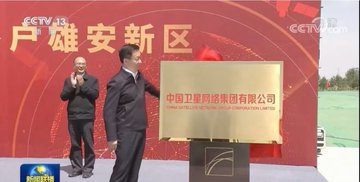The Satcom Industry in China: Accelerating to ‘China Speed’
by Blaine Curcio
Hong Kong, July 5, 2021--Having lived in Shenzhen for a handful of years, I would hear time and time again about things developing at “Shenzhen Speed.” In local parlance, the peak of Shenzhen Speed coincided with the early-1990s to mid-2000s building boom, when some buildings went up at a rate of 4 floors every 9 days. In the broader Chinese context, the phrase “China Speed” also gets used often, referring to industries developing quickly or infrastructure being built in the blink of an eye.
Over the past several years, parts of the Chinese space sector have grown at China speed. This includes launch vehicles, satellite manufacturing, and EO and satnav applications. Somewhat absent from this acceleration to China speed has been satcom—until recently. The past year and a half have seen the acceleration of Starlink, and a subsequent acceleration in China by policymakers, companies, and investors to build the infrastructure needed for a “Chinese Starlink”. At the same time, the continued advent of HTS and development of end user applications that are more mainstream than before (in-flight broadband vs. VSATs in remote villages), has led to more impetus by Chinese satellite operators to launch HTS capacity and vertically integrate into high-growth parts of the industry. The first half of 2021 saw quite a few significant events in China’s satcom sector, including funding rounds into service providers, events surrounding different end verticals, and the topping out of a billion-dollar satcom tower. Here, we will discuss half-year updates in the GEO satcom and LEO satcom sectors, deriving insights and analysis from the recently-released Euroconsult China Space Industry Quarterly, Q1 and Q2 2021 Edition.
GEO Satcom: Enter HTS, Open the Downstream
China’s GEO satcom market has long been more or less a monopoly, with China Satcom controlling much of the capacity, and a few big service providers, including ChinaSat subsidiary SinoSat, have controlled the services part of the industry. More recently, as satellite internet has become more strategically important in China, there has been impetus to launch more capacity, which has created more opportunities for service providers downstream.
The additional capacity has thus far taken the form of the Apstar-6D satellite, launched by APT Mobile Satcom, a Shenzhen-based partial subsidiary of the Hong Kong-based APT Satellite. The satellite brought some dozens of Gbps of Ku-band capacity to the APAC region, with a focus on IFC and to some extent maritime. At an IFC conference in Shanghai in May of this year, we saw a representative of AeroNet, an IFC-focused subsidiary of China Satcom, present a coverage map of 3x GEO-HTS satellites to be launched by ChinaSat by 2023 over the broader APAC region totaling 400 Gbps of Ka-band capacity (slide below at right). On the supply side of the GEO satcom industry, the first half of the year also saw the launch of the 3rd Tiantong-1 satellite, which completes the GEO MSS constellation that aims to offer a sort of “Chinese version of Iridium-4”, which is to say a global narrowband MSS constellation. Overall, China saw quite a H1 2021 on the supply side of the GEO satcom industry.
Looking at the demand side, we also saw some significant updates. In the IFC vertical, China Satcom continued to grow its IFC-focused subsidiary, the aforementioned AeroNet. The company was created to commercialize ChinaSat-16 Ka-band HTS capacity, and future HTS capacity, in the IFC sector, with a management team that largely comes from ChinaSat’s internal Ka-band R&D center. We also saw TDLink, a Chinese IFC service provider, sign an agreement that will extend the company cooperation with Qingdao Airlines, the first airline in China to do commercial IFC services (late 2020).
In the maritime sector, the first half of the year saw Shenzhen-based maritime service provider Sky and Sea World raise an undisclosed amount of funding from Mengsheng Electronics, a publicly-traded electronics manufacturer. Around the same time, Ningbo-based Ditel, another maritime satcom service provider, announced groundbreaking on their new headquarters, which will include a Ku-band gateway for utilizing Apstar-6D capacity. At the time, the company noted that their network will see a 10x increase in bandwidth, from 1 Gbps to 10 Gbps.
Land mobility also saw some interesting updates, with the Yangtze River Delta International Emergency Expo in May seeing new terminals announced by GeeSpace and SatPro. That being said, despite all the updates in the GEO satcom sector over the first half of 2021, LEO satcom saw arguably much more significant events taking place, partly in response to Starlink.
LEO Satcom: Hitting the Ground Running
China’s LEO satcom industry did not really exist as recently as 10 years ago, in the sense that the country had a fair number of satellites in LEO, but almost all were either for scientific research, government missions, or other pretty turnkey projects. Ideas such as mass manufacturing of smallsats, or rockets that could send tens of tons to LEO, were in their infancy, or not in the picture at all. How that has changed in just the past 2 years, and with an acceleration in 2021.
A short review: in April 2020, the National Development and Reform Commission (NDRC), a high-level governmental body, added “satellite internet” to its list of “New Infrastructures”, a list of digital infrastructures that the government wants to prioritize for investment. In the months that followed, companies raised money for satellite factories, application development, and other parts of what will be a large and sprawling industrial base.
 |
| China launches “China SatNet.” a company directly under the State-Owned Assets Supervision and Administration Commission (SASAC i.e. at the same level as the big 3 telcos, CASC, and CASIC), with the purpose of operating a LEO constellation. (image courtesy of CCTV) |
2021 has thus far seen the publication of China’s 14th Five-Year Plan, covering the period of 2021-2025, and the plan includes a global constellation of communications satellites. We have also seen the establishment of a “China SatNet” company, a company directly controlled by the State-Owned Assets Supervision and Administration Commission (SASAC), and which is tasked with operating China’s LEO broadband constellation, currently known as the GuoWang project. China SatNet will likely have significant autonomy over procurement, administration, and other decisions, as it finds itself at the same level of the state-owned enterprise hierarchy as space industry giants CASC and CASIC, as well as the three telcos.
Since the establishment of China SatNet, it’s leadership—primarily taken from a variety of SOEs including the aforementioned CASC and CASIC—has traveled to multiple cities to speak with local leaders about developing synergies between SatNet and their existing industrial bases. Noteworthily, SatNet leadership signed an agreement with the city of Chongqing for co-development of a satellite industrial base. It is likely no coincidence that Chongqing is the focus city of Hongyan, the CASC LEO broadband constellation project that is likely to be rolled into GuoWang. By meeting with the Chongqing officials, SatNet leadership can better ascertain what they are working with in Chongqing in terms of industrial development, and likely discuss areas to collaborate.
Ultimately, a very powerful company with a clear mandate to centralize China’s disparate LEO broadband constellation plans (no less than 6-7 have been talked about over the years), China SatNet represents a major step in the development of China’s response to Starlink. Over the past 2 months, we have seen multiple prominent scholars and officials speaking to official media about the need for China to organize a fast and well-coordinated response to Starlink, and the idea that SatNet is that response. Most recently, this included Bian Yongzu, a researcher at the Center for International Security and Strategy of Tsinghua University, speaking about the need for a response to Starlink, and the role that the commercial sector can play in filling that need.
Conclusion
The satcom market in China has historically been pretty limited. Excellent terrestrial infrastructure, a monopolistic industry, and limited incentives to grow have contributed to this. More recently, this has begun to change, with the government supporting the sector, with a degree of opening up in the downstream part of the industry, and, perhaps most importantly, with a lot of new capacity coming into the market. Moving forward, it’s not entirely clear how all these variables will play out, but a likely outcome is that they will develop at China Speed.
---------------------------------------------------------

Blaine Curcio is the Founder of Orbital Gateway Consulting. He’s an expert on the commercial space and satellite industries with a focus on the Asia-Pacific region. He can be reached at: blaine@orbitalgatewayconsulting.com
For the latest news and analysis on the China Space market, Blaine Curcio hosts a weekly podcast called Dongfang Hour. It can be viewed at: https://dongfanghour.com/






